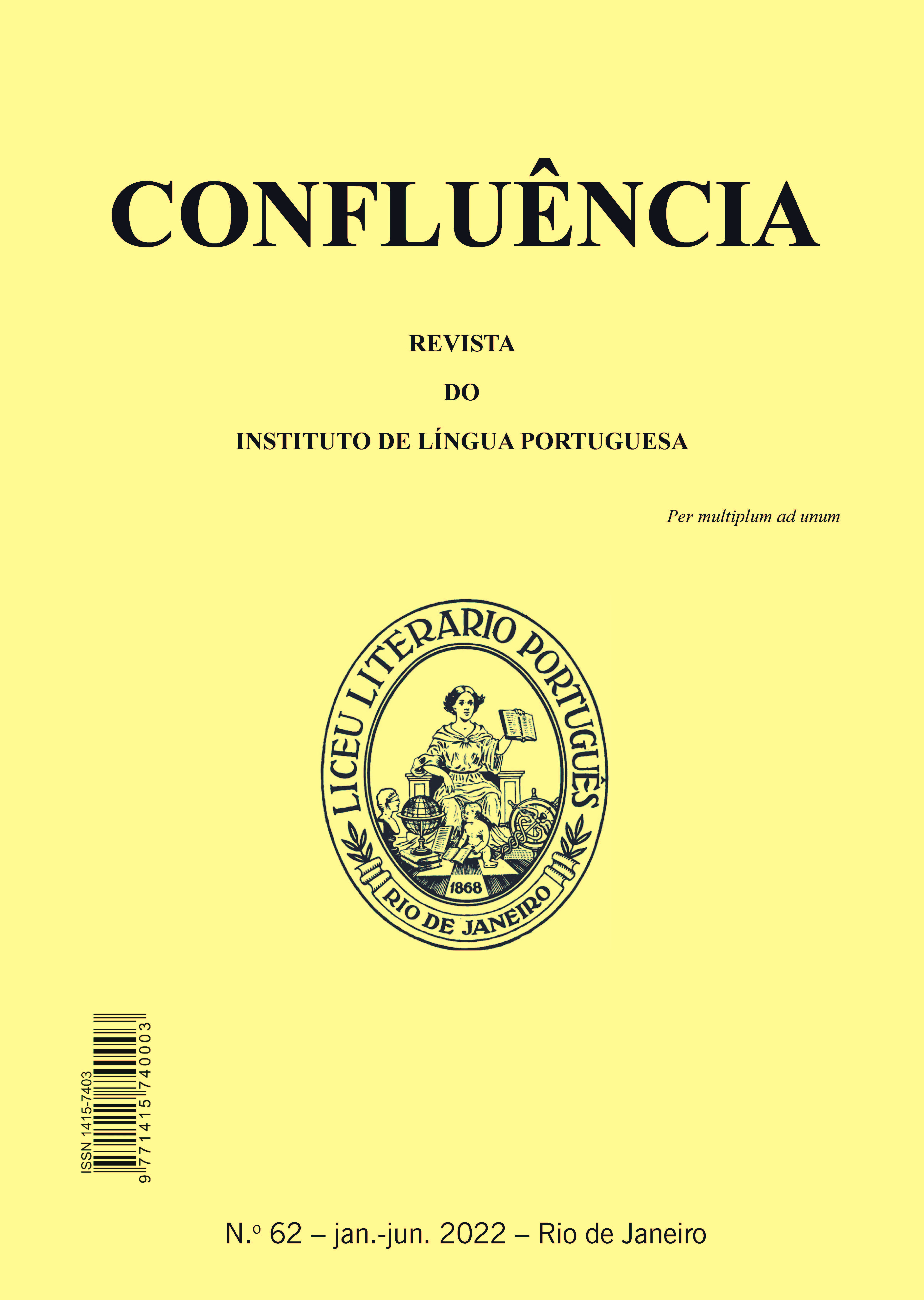O papel do conector aliás na articulação de argumentos e na construção de imagens identitárias
DOI:
https://doi.org/10.18364/rc.2022n62.512Parole chiave:
conector aliás, argumentação, debate eleitoral.Abstract
Procedemos, neste trabalho, ao estudo dos usos do conector aliás no último debate eleitoral da campanha à Presidência da República do Brasil, ocorrida em 2018, investigando o modo como as onze ocorrências do conector constantes do debate auxiliam na articulação e hierarquização de argumentos, na defesa de pontos de vista e na construção de imagens identitárias pelos candidatos. A perspectiva teórica que seguimos é a da Semântica da Enunciação (ou Pragmática integrada). No debate, identificamos dois usos do conector, um em que introduz um argumento suplementar e outro em que introduz uma correção ou retificação. Em ambos os usos, o conector, indicando rupturas enunciativas entre os argumentos que conecta, desempenha um papel estratégico. Empregando-o, o locutor busca atribuir diferentes graus de importância aos argumentos, graduar a maior ou menor amplitude de seu público-alvo, bem como poupar-se de ataques, corrigindo-se.
Downloads
Riferimenti bibliografici
ALMEIDA, D. M. V. O marcador do discurso aliás e suas possibilidades para a língua espanhola. Entretextos, Londrina, v. 13, n. 2, p. 344-362, 2013.
ANSCOMBRE, J. C.; DUCROT, O. L’argumentation dans la langue. Liège: Pierre Mardaga, 1983.
BECHARA, E. Moderna gramática portuguesa. Rio de Janeiro: Nova fronteira, 2009.
CASTRO, M. C. L. A estratégia discursiva original do conector “aliás”. Moara, Belém, n. 8, p. 81-94, 1997.
CUNHA, G. X. A construção de imagens de si no discurso organizacional. In: TOMAZI, M. M.; ROCHA, L. H. P.; POMPEU, J. C. (orgs.). Estudos discursivos em diferentes perspectivas: mídia, sociedade e direito. São Paulo: Terracota Editora, 2016, p. 111-126.
CUNHA, G. X.; BRAGA, P. B.; BRITO, D. M. As funções figurativas do comentário metadiscursivo em debates eleitorais. Cadernos de linguagem e sociedade, Brasília, v. 20, n. 2, p. 168-187, 2019.
DUCROT, O. O dizer e o dito. Campinas: Pontes, 1987.
DUCROT, O.; BOURCIER, D.; BRUXELLES, S.; DILLER, A. M.; FOUQUIER, É.; GOUAZE, J.; SIRDAR-ISKANDAR, C. Les mots du discours. Paris: Minuit, 1980.
GOFFMAN, E. On face-work: an analysis of ritual elements in social interaction. In: GOFFMAN, E. Interaction Ritual: essays on face-to-face behavior. New York: Pantheon Books, 1967. p. 5-45.
GRICE, H. P. Logic and conversation. In: COLE, P.; MORGAN, J. L. (eds.). Sintax and semantics: Speech Acts, v. 3. New York: Academic Press, 1975. p. 41-48.
RAMOS, N. R. Usos semântico-pragmáticos de aliás: uma análise centrada no uso. 2019. 92f. Dissertação (Mestrado em Estudos de Linguagem) – Faculdade de Letras, Universidade Federal Fluminense, Niterói, 2019.
RAMOS, N. R. A multifuncionalidade de aliás: valores semânticos em perspectiva funcional. Working Papers em Linguística, Florianópolis, v. 21, n. 1, p. 220-240, 2020.
ROSÁRIO, I. C.; RAMOS, N. R. Aspectos morfossintáticos e usos semântico-pragmáticos de aliás - uma análise centrada no uso. Confluência, Rio de Janeiro, n. 58, p. 106-134, 2020.
KERBRAT-ORECCHIONI, C. Les débats de l’entre-deux-tours des élections présidentielles françaises: constantes et évolutions d’un genre. Paris: L’Harmattan, 2017.
KOCH, I. G. V. A inter-ação pela linguagem. São Paulo: Contexto, 1997.
KOCH, I. G. V. Introdução à Linguística Textual. São Paulo: Martins Fontes, 2006.
KOCH, I. G. V. Argumentação e linguagem. São Paulo: Cortez, 2008.
KOCH, I. G. V. A coesão textual. São Paulo: Contexto, 2009.
LAROUSSE: francês-português/português-francês. São Paulo: Larousse do Brasil, 2008.
LOPES, A. C. M. Aliás: A contribution to the study of a Portuguese discourse marker. In: GHEZZI, C.; MOLINELLI, P. (eds.). Discourse and Pragmatic Markers from Latin to the Romance Languages. Oxford: Oxford University Press, 2014. p. 211-221.
LOPES, A. C. M. Texto, relações discursivas e ensino. In: LOHÖFER, A.; SÜSELBECK, K. (eds.). Streifzüge durch die Romania. Festschrift für Gabriele Beck-Busse zum 60. Geburtstag. Sttutgart: Ibidem-Verlag, 2017. p. 1-14. Disponível em: https://eg.uc.pt/handle/10316/47882.
LUSCHER, J. M. Les marques de connexion: des guides pour l’interprétation. MOESCHLER, J. et al. Langage et pertinence: référence temporelle, anaphore, connecteurs et métaphore. Nancy: Presses Universitaires de Nancy, 1994. p. 175-228.
MAINGUENEAU, D. Novas tendências em Análise do Discurso. Campinas: Pontes, 1997.
MAROTE, J. T. O. (org.). Minidicionário francês-português/português-francês. São Paulo: Ática, 2002.
MICHAELIS. D’ailleurs. São Paulo: Melhoramentos, 2021. Disponível em: https://michaelis.uol.com.br/palavra/odQqo/d%E2%80%99ailleurs/.
OLIVEIRA, H. F. Os conectores reformulativos. SCRIPTA, Belo Horizonte, v. 5, n. 9, p. 229-233, 2001.
PORTOLÉS, J. Marcadores del discurso y traducción. In: PALACIOS, J. G.; FUENTES, M. T. (eds.). Texto, terminologia y traducción. Salamanca: Almar, 2002. p. 145-167.
ROSSARI, C. Les opérations de reformulation: analyse du processus et des marques dans une perspectiva contrastive français-italien. Berne: Peter Lang, 1993.
ROSSARI, C. Connecteurs et relations de discours: des liens entre cognition et signification. Nancy: Presses Universitaires de Nancy, 2001.
ROULET, E.; AUCHLIN, A.; MOESCHLER, J.; RUBATTEL, C.; SCHELLING, M. L’articulation du discours en français contemporain. Berne: Peter Lang, 1985.
ROULET, E.; FILLIETTAZ, L.; GROBET, A. Un modèle et un instrument d’analyse de l’organisation du discours. Berne: Peter Lang, 2001.
Downloads
Pubblicato
Fascicolo
Sezione
Licenza
Copyright (c) 2021 Gustavo Ximenes Cunha

Questo lavoro è fornito con la licenza Creative Commons Attribuzione - Non commerciale 4.0 Internazionale.
Gli autori che pubblicano in questa rivista accettano i seguenti termini: a. Gli autori conservano i diritti d'autore e concedono alla rivista il diritto di prima pubblicazione, con l'opera contemporaneamente concessa in licenza con una licenza di attribuzione Creative Commons che consente la condivisione dell'opera con riconoscimento della paternità e prima pubblicazione su questa rivista. b. Gli autori sono autorizzati ad assumere ulteriori contratti separatamente, per la distribuzione non esclusiva della versione dell'opera pubblicata su questa rivista (es. pubblicazione in un repository istituzionale o come capitolo di libro), con riconoscimento della paternità e pubblicazione iniziale in questo rivista. c.Gli autori sono autorizzati e incoraggiati a pubblicare e distribuire il loro lavoro online (ad es. in archivi istituzionali o sulla loro pagina personale) in qualsiasi momento prima o durante il processo editoriale, poiché ciò può generare cambiamenti produttivi oltre ad aumentare l'impatto e la citazione di opera pubblicata


